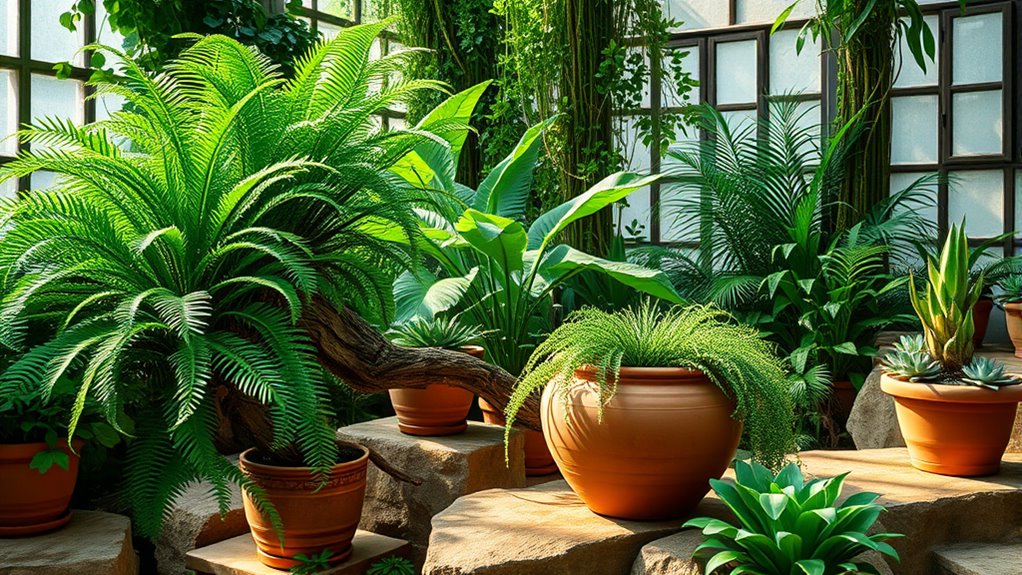Biophilic color schemes using greens and earth tones help you create calming, nature-inspired spaces that promote well-being and harmony. By bringing in shades reminiscent of forests, soil, and mountains, you connect more deeply with the outdoors. Adding indoor plants and maximizing natural light enhances this effect, making your environment feel vibrant and restful. If you keep exploring, you’ll discover how to optimize these elements to transform your space into a soothing sanctuary.
Key Takeaways
- Biophilic color schemes incorporate greens and earthy tones to evoke nature and promote well-being.
- These colors enhance natural lighting effects, making indoor spaces feel brighter and more inviting.
- Pairing earthy tones with indoor plants deepens the connection to outdoor environments.
- Such schemes foster a calming atmosphere that supports mental and physical health.
- Optimizing natural light amplifies the soothing impact of greens and earth tones in interior design.

Biophilic color schemes draw inspiration from nature to create environments that promote well-being and harmony. When you choose shades of green and earthy tones, you’re not just decorating—you’re designing a space that nurtures your mind and body. These colors evoke the calming essence of forests, mountains, and soil, helping you feel grounded and refreshed. To truly maximize the benefits of a biophilic palette, you should consider integrating indoor plants. Not only do they add vibrant green accents, but they also enhance the natural vibe of your space, creating a seamless connection with the outdoors. With strategic indoor plant placement, you can foster a sense of vitality and tranquility that radiates throughout your environment. Pairing these plants with your color choices deepens the biophilic effect, making your space more inviting and soothing.
Natural lighting optimization plays a fundamental role in elevating the impact of your color scheme. Sunlight has a way of amplifying earthy tones and greens, making them appear more vivid and alive. To achieve this, you should maximize your windows’ exposure to natural light. Keep window treatments light and minimal to allow sunlight to flood your space, which will enhance the natural hues and create a warm, welcoming atmosphere. If direct sunlight is limited, consider using reflective surfaces or light-colored furnishings to bounce light around the room. The combination of well-lit spaces and biophilic colors fosters a sense of openness and serenity, helping you feel more connected to nature even indoors. Additionally, understanding the importance of proper light exposure can support your overall well-being and the health of your indoor plants.
Moreover, natural lighting doesn’t just improve the visual appeal of your color scheme; it also supports your overall well-being. Exposure to natural light regulates your circadian rhythms, boosts mood, and increases productivity. When paired with indoor plant integration, natural lighting optimization transforms your environment into a restorative sanctuary. You’ll notice your space feeling more alive and balanced, encouraging relaxation and focus. The synergy between these elements creates a holistic environment that nurtures your mental and physical health.
Frequently Asked Questions
How Do Biophilic Colors Impact Mental Health?
Using biophilic colors like greens and earth tones enhances your mental health by strengthening your nature connection, which can lead to stress reduction. These calming colors evoke a sense of tranquility, helping you feel more relaxed and centered. When you incorporate them into your environment, you promote emotional well-being and create a soothing space that supports mental clarity and resilience during challenging times.
Can These Color Schemes Be Adapted for Small Spaces?
Did you know small spaces benefit from biophilic colors just as much as larger ones? You can adapt these schemes with space-saving paint techniques and multifunctional color palettes to make your area feel more open and calming. Using lighter greens and earth tones on walls, combined with strategic accents, enhances the space’s natural vibe without overwhelming it. This approach boosts mental well-being while keeping your small space lively and inviting.
What Are the Best Materials to Complement Green and Earth Tones?
You should choose natural wood and stone accents to complement green and earth tones effectively. Natural wood adds warmth and texture, enhancing the organic feel of your space, while stone accents provide a grounding, tactile element that pairs beautifully with these colors. Both materials bring a sense of nature indoors, creating a harmonious environment. Incorporate these elements through furniture, decor, or feature walls to enrich your biophilic design.
How Do Lighting Conditions Affect Biophilic Color Perception?
Imagine you’re living through the Renaissance, but with modern lighting—lighting variability can drastically influence how you perceive greens and earth tones. Bright, natural light enhances perception accuracy, making colors vibrant and true to life. Conversely, dim or artificial lighting skews these hues, dulling or altering their appearance. You need to evaluate lighting conditions carefully to maintain the calming, natural feel of biophilic spaces, ensuring colors stay authentic regardless of the environment.
Are There Cultural Considerations in Choosing Specific Greens and Earth Tones?
Yes, cultural symbolism and regional preferences influence your choice of greens and earth tones. You should contemplate how different cultures perceive these colors; for example, green symbolizes luck in some regions but can represent envy elsewhere. Regional preferences also shape your palette, as certain shades resonate more deeply with local traditions and environments. Being mindful of these factors guarantees your color scheme feels meaningful and appropriate to your audience.
Conclusion
By embracing greens and earth tones, you bring nature’s calming embrace into your space, transforming it into a sanctuary that nurtures your soul. These colors serve as a bridge to the outdoors, wrapping you in a soothing, organic embrace. When you incorporate biophilic color schemes, you’re not just decorating—you’re cultivating a haven that breathes life and tranquility into every corner. Let these hues be the steady heartbeat of your space, grounding you in nature’s timeless rhythm.










